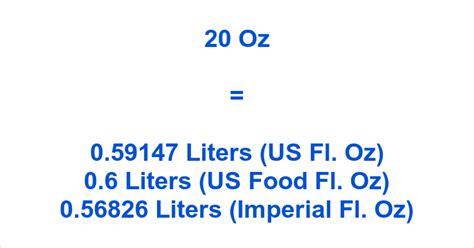20 Ounces Is How Many Liters
Kalali
Apr 06, 2025 · 4 min read

Table of Contents
20 Ounces is How Many Liters? A Comprehensive Guide to Unit Conversion
Understanding unit conversions is crucial in various aspects of life, from cooking and baking to scientific research and international trade. One common conversion that often causes confusion is converting ounces (oz) to liters (L). This comprehensive guide will delve deep into the conversion of 20 ounces to liters, explaining the process, offering different methods, exploring related conversions, and addressing common misconceptions. We'll also touch upon the importance of precision in unit conversions and how to avoid common errors.
Understanding the Units: Ounces and Liters
Before we dive into the conversion, let's establish a clear understanding of the units involved:
-
Ounces (oz): An ounce is a unit of weight or mass. There are two main types of ounces: fluid ounces (fl oz), used for measuring volume of liquids, and avoirdupois ounces, used for measuring the weight of solid objects. This is a crucial distinction! When converting to liters, we are almost always dealing with fluid ounces.
-
Liters (L): A liter is a metric unit of volume. It's the base unit of volume in the International System of Units (SI). One liter is equal to 1 cubic decimeter (dm³), or 1000 cubic centimeters (cm³).
Converting 20 Fluid Ounces to Liters: The Calculation
The conversion factor between fluid ounces and liters is approximately 0.0295735 liters per fluid ounce. Therefore, to convert 20 fluid ounces to liters, we perform the following calculation:
20 fl oz * 0.0295735 L/fl oz ≈ 0.59147 L
Therefore, 20 fluid ounces is approximately 0.59 liters.
Different Methods for Conversion
While the direct multiplication method is the most straightforward, several other methods can be used for converting fluid ounces to liters:
-
Using online converters: Numerous online conversion tools are readily available. Simply input the value in fluid ounces, and the tool will provide the equivalent in liters. These tools can be particularly useful for quick conversions or for verifying calculations.
-
Employing conversion tables: Many reference books and websites provide comprehensive conversion tables listing equivalent values between different units. These tables can be a handy resource for quick lookups, particularly when dealing with multiple conversions.
-
Applying dimensional analysis: This mathematical technique helps ensure that the units cancel out correctly, leaving only the desired unit. It's a more robust method for complex conversions involving multiple unit changes.
Precision and Significant Figures
The precision of your conversion depends on the precision of the conversion factor you use. The conversion factor of 0.0295735 L/fl oz is an approximation. Using more decimal places will lead to a more precise result, but for most practical purposes, the result of 0.59 liters is sufficient. Understanding significant figures is crucial in ensuring the accuracy and reliability of your conversions. You should always round your final answer to the appropriate number of significant figures based on the least precise measurement in your calculation.
Common Mistakes to Avoid
Several common pitfalls can lead to incorrect conversions:
-
Confusing fluid ounces and avoirdupois ounces: This is perhaps the most common error. Remember, you're converting fluid ounces to liters, not avoirdupois ounces.
-
Using an incorrect conversion factor: Ensure you are using the correct conversion factor of approximately 0.0295735 L/fl oz. Using an outdated or inaccurate factor will result in an inaccurate conversion.
-
Incorrect rounding: Pay close attention to significant figures to ensure appropriate rounding.
Related Conversions
Understanding the conversion between fluid ounces and liters often leads to needing related conversions. For example:
-
Converting liters to milliliters: 1 liter = 1000 milliliters (mL). This conversion is particularly useful when dealing with smaller volumes.
-
Converting fluid ounces to gallons: 1 US gallon ≈ 128 fluid ounces. This is helpful when working with larger volumes.
-
Converting liters to cubic centimeters: 1 liter = 1000 cubic centimeters (cm³). This is frequently used in scientific contexts.
-
Converting liters to cubic feet: 1 liter ≈ 0.0353 cubic feet.
Practical Applications of Fluid Ounce to Liter Conversions
The ability to accurately convert fluid ounces to liters finds application in a wide variety of scenarios:
-
Cooking and Baking: International recipes often use metric units. Converting fluid ounces to liters ensures accurate measurements.
-
Science and Research: Many scientific experiments and studies require precise volume measurements.
-
Medicine: Accurate dosage calculation in medicine often involves converting between units.
-
International Trade: Facilitates trade by enabling easy conversion between different unit systems.
-
Travel: Understanding volume conversions is helpful when dealing with liquids while travelling internationally.
Conclusion: Mastering the Art of Unit Conversion
Converting 20 fluid ounces to liters, approximately 0.59 liters, is a simple yet fundamental task with wide-ranging applications. By understanding the units, employing appropriate methods, paying attention to precision, and avoiding common mistakes, you can confidently perform these conversions in various contexts. This knowledge proves invaluable in navigating daily life, pursuing academic or professional goals, and engaging in numerous practical activities where precise measurements are essential. Mastering unit conversions elevates your understanding of the world and empowers you to effectively tackle challenges that involve different systems of measurement.
Latest Posts
Latest Posts
-
250 Mg Is How Many Grams
Apr 08, 2025
-
How Many Degrees Celsius Is 30 Degrees Fahrenheit
Apr 08, 2025
-
How Tall Is 31 Inches In Feet
Apr 08, 2025
-
Whats A 30 Out Of 50
Apr 08, 2025
-
Surface Area Of Prisms And Cylinders Answer Key
Apr 08, 2025
Related Post
Thank you for visiting our website which covers about 20 Ounces Is How Many Liters . We hope the information provided has been useful to you. Feel free to contact us if you have any questions or need further assistance. See you next time and don't miss to bookmark.